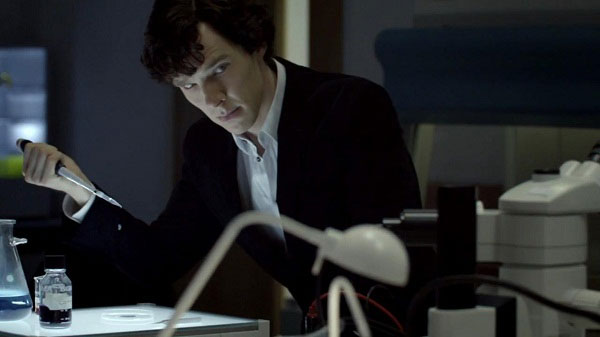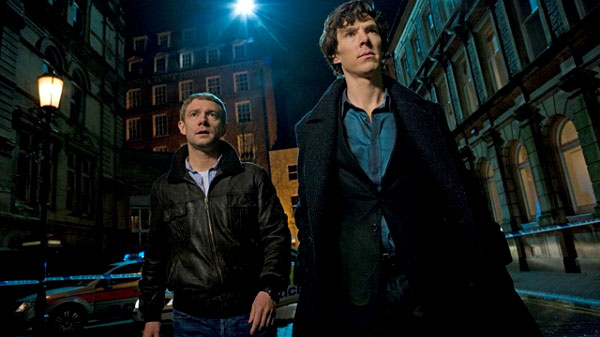
Right
about now Robert Downey Jr. is working on the big-screen sequel to last
year’s adrenalized version of Sherlock Holmes from Lock, Stock and
Two Smoking Barrels director Guy Richie. In the meantime, Conan
Doyle nuts can get their fix with the first series of Sherlock,
a modern day take on the classic sleuth from acclaimed Coupling
and Doctor Who screenwriter, Steve Moffat.
The
Guinness Book of Records cites Sherlock Holmes as the “most portrayed
movie character,” with 75 actors having played the part in over 200
films, and it’s no surprise why. This Sherlock calls himself, “a
highly-functioning sociopath,” gifted in the art of deduction but with
little interest in anything other than the mental challenge of solving
complex crimes. He’s asexual, indifferent to social conventions, and
(not without good reason), often arrogant. It’s up to his more
socially-adept friend and flatmate, Dr. John Watson, to help him to
function in a world so averse to the extraordinary.

Holmes
is a freelance detective, called in by Scotland Yard’s Detective
Inspector Lestrade, who is here portrayed charismatically by Rupert
Graves as himself a very competent detective (as distinct from, for
instance, Eddie Marsan’s comedic portrayal in Richie’s version). Holmes
superpower – and he is, in modern terms, a superhero – is his obsessive
sense of observation and ability to perform outstanding feats of
deduction. The most logical of heroes he, like Hugh Laurie’s House (who
is partly based on Holmes) is both similar and the complete opposite of
an equally outcast, and equally work-obsessed, figure like The
X-Files Fox Mulder, who by contrast is highly intuitive rather than
rational.
Aside
from the consistently witty (and often funny) writing, the strength of
this version, presented as three 90-minute BBC telemovies (“A Study in
Pink”, ”The Blind Banker” and “The Great Game”), is the brilliant
performances from the wonderfully named Benedict Cumberbatch as Holmes,
and Martin Freeman as Watson, and the seamless way in which familiar
elements are updated to the present day. Holmes as an anti-social drug
addict? He loves texting, hovers on Internet message boards and has
three nicotine patches to calm his racing brain. Watson’s journals? He
keeps a blog. And the eponymous Hansom cabs? The classic, and absurdly
expensive, London black cabs. The latter is one of the few concessions
to fidelity over common sense, as co-creator Mark Gatiss says in one of
the two audio commentaries: it just wouldn’t be Sherlock Holmes if they
were commuting to a crime scene on a public bus.
The
first and last of the films are the strongest and are directed by
stylish film-director Paul McGuigan (Lucky Number Slevin). He
gives the series an energetic visual style leagues above the bland
60-minute unaired pilot version of “A Study in Pink” (a curiosity
included as an extra on the second disc). One of his most impressive,
and elegant contributions, is presenting Holmes’ SMS messages as
on-screen text, thus preventing the need for inserts and emphasizing the
slick, modern take on the material.

Downey’s
Jr.’s take on Holmes is entertaining, but he’s unfortunately constrained
by the necessities of the big-budget blockbuster film. Sherlock
is truer, more fascinating portrait of this oddly attractive character.
Freeman and Cumberbatch nail the at times prickly but close relationship
between Holmes and Watson, a friendship all the more fascinating for
what is left unsaid. Holmes especially has bigger things on his mind –
not least of which is the looming supervillain Moriarty who, on the
basis of the cliffhanger which ends this season, may become the focus of
the second series when it rolls around in mid-2011.
Audio
& Video
The
two-disc blu-ray is technically peerless. The evocative greys and blues
of wintery contemporary London are crisp, and McGuigan’s slick shooting
almost reaches J.J. Abrams’ level of lens flare. The 5.1 mix is nicely
balanced without being extraordinary, and David Arnold and Michael
Price’s zippy score is both energetic and hummable, even if it seems to
stylistically borrow from Hans Zimmer’s racing-brain take on the
character.
Special
Features
In
addition to the original 60-min pilot version of “A Study in Pink” and a
half-hour behind the scenes documentary (“Unlocking Sherlock”), there
are two entertaining feature commentaries. The first, on “A Study in
Pink,” is from co-creators Moffat and Gatiss and producer Sue Vertue. It
covers the series’ creation as born over numerous train-journeys on the
commute to work on Doctor Who (where Moffat is currently
executive producer). The second, on “The Great Game,” features Gatiss,
Cumberbatch and Freeman, which after a slow start becomes highly
entertaining and informative. It’s worth it for Cumberbatch’s
hysterical Alan Rickman impersonation alone.